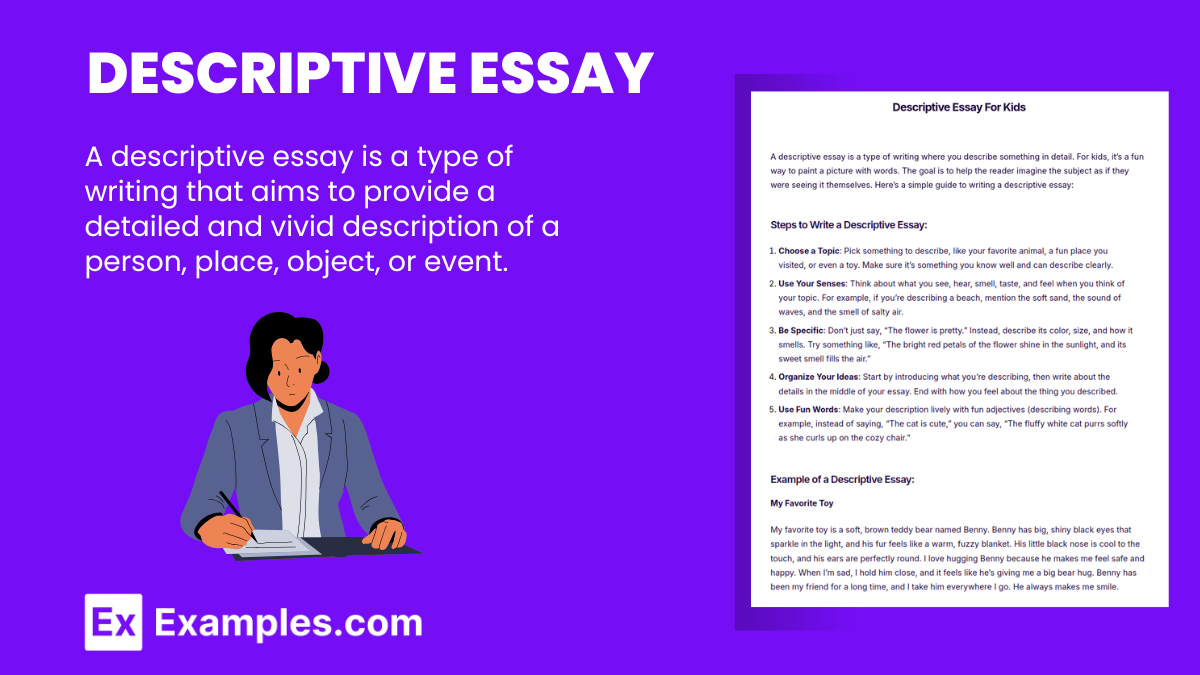16+ Descriptive Essay Examples
Essays are written due to various reasons and purposes. Some of the authors want to inform, some want to expose while some want to persuade. However, in descriptive essay writing, the essayist composes for the sake of displaying a picture out of his/her describing words. It may sound easy and simple but don’t be deceived, there are still more to learn. Read through this article to get hold of significant and beneficial new knowledge.
What is Descriptive Essay?
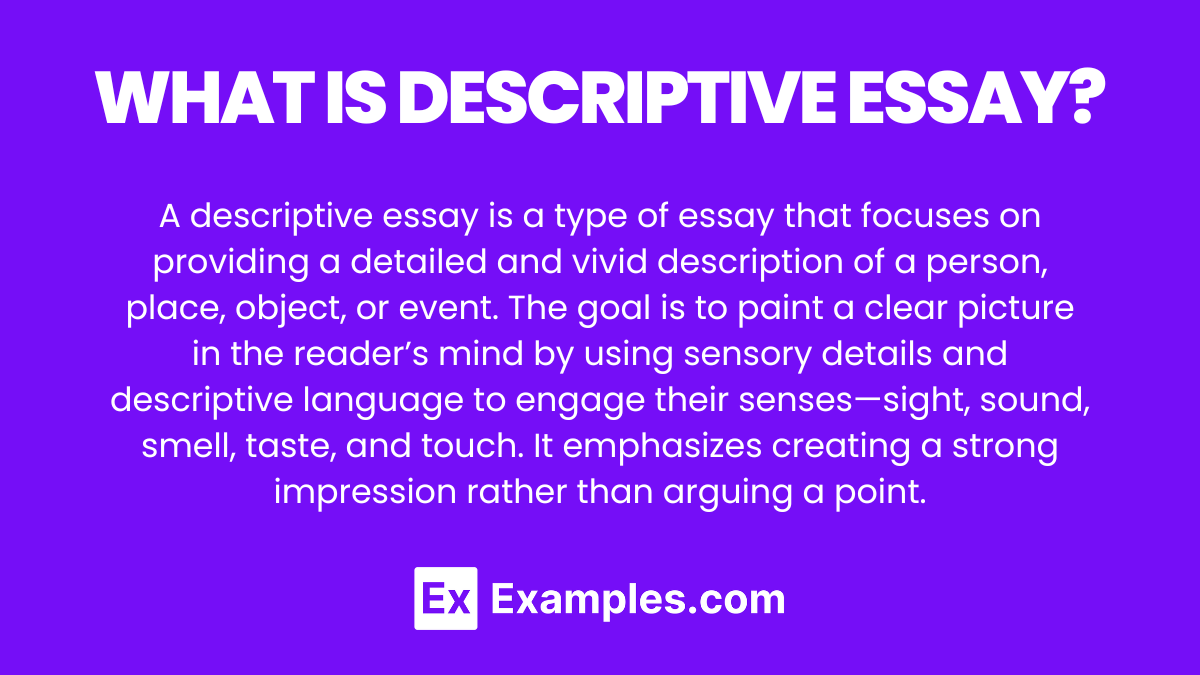
Descriptive Essay Bundle
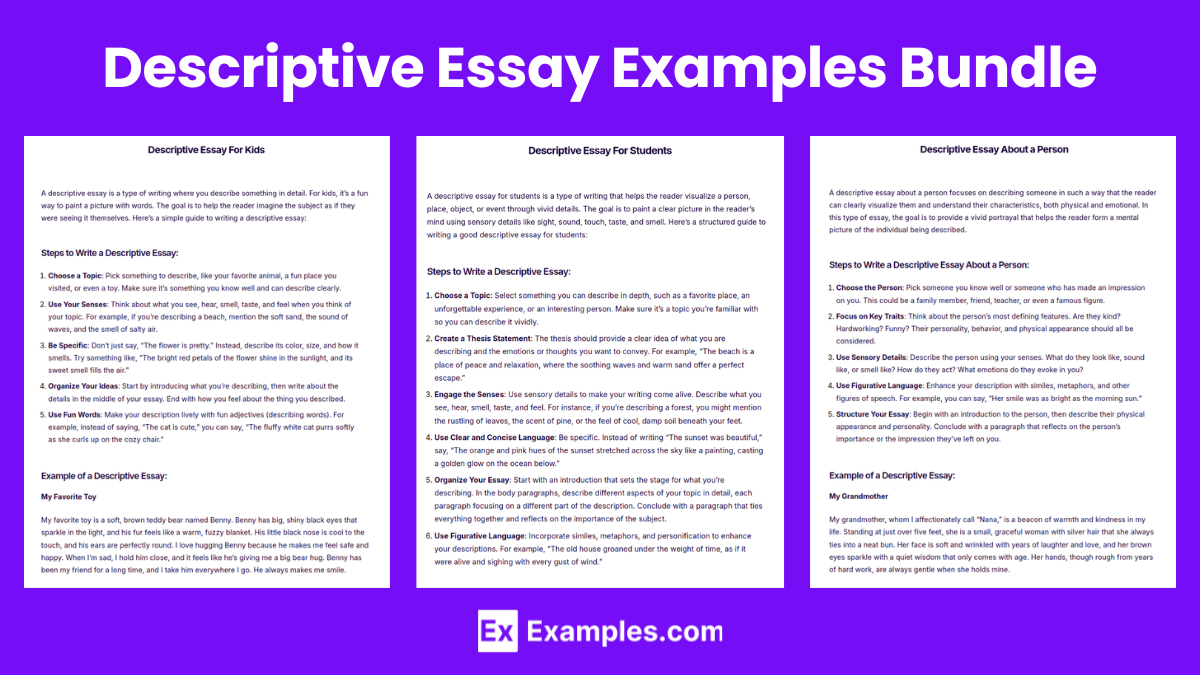
Download Descriptive Essay Bundle
Descriptive Essay Format
Introduction
- Hook: Start with a sentence that captures the reader’s attention. This could be a striking fact, a question, or a vivid description.
- Context: Provide some background information to set the scene. Describe the setting, the situation, or the object of the essay.
- Thesis Statement: End the introduction with a clear thesis statement that outlines the main aspects or the overall impression of your subject.
Body Paragraphs
Each body paragraph should focus on a specific aspect or a detail that contributes to the overall picture you are trying to paint. Use the “show, don’t tell” technique by employing vivid imagery and sensory details.
Paragraph 1: Sight
- Topic Sentence: Introduce the aspect of sight.
- Details: Describe what you see in vivid detail. Use adjectives and adverbs to bring the scene to life.
- Closing Sentence: Wrap up the paragraph by summarizing the importance of the visual details.
Paragraph 2: Sound
- Topic Sentence: Focus on the sounds related to your topic.
- Details: Describe what can be heard, whether it’s the background noise, a specific sound related to the subject, or the absence of sound.
- Closing Sentence: Conclude by explaining how the sounds contribute to the overall impression.
Paragraph 3: Smell
- Topic Sentence: Highlight the aspect of smell.
- Details: Describe the aromas and scents. Whether it’s pleasant or pungent, detail how it impacts the scene or the subject.
- Closing Sentence: Summarize how the smell adds to the depth of your description.
Paragraph 4: Touch
- Topic Sentence: Discuss the sense of touch.
- Details: Describe the textures and temperatures. Explain how something feels to the touch and why it’s important to your description.
- Closing Sentence: Link the tactile details to the overall experience.
Paragraph 5: Taste (if applicable)
- Topic Sentence: Introduce the sense of taste, if relevant.
- Details: Describe the flavors and the experience of tasting something related to your subject.
- Closing Sentence: Reflect on how taste enhances the description.
Conclusion
- Summary: Briefly restate your thesis and summarize the main points of your essay.
- Significance: Explain the significance of the subject and the impact it has made on you or the impression it leaves.
- Closing Thought: End with a final thought or reflection, leaving the reader with something to ponder.
Example of Descriptive Essay
“The Sunset at the Beach”
As I walked down the sandy path towards the ocean, the first thing that struck me was the vast expanse of the sea, stretching endlessly towards the horizon. The sun was beginning to set, painting the sky in shades of orange, pink, and purple. The beauty of the sunset at the beach was a breathtaking spectacle that I had come to witness.
Introduction
The beach has always been a place of serenity for me, especially during the sunset. The way the sun dipped below the horizon, leaving behind a tapestry of colors, always seemed magical. On this particular evening, the scene was set for a perfect display of nature’s artistry.
Body Paragraphs
The Vision of the Sunset
As I stepped onto the soft, warm sand, my eyes were immediately drawn to the horizon. The sun, a fiery orb, was slowly descending, casting its golden glow across the sky. The clouds, mere wisps earlier in the day, now looked like cotton candy, stained with hues of pink and lavender. The reflection of the sunset on the water added a layer of brilliance to the scene, with the light dancing on the waves as they gently lapped against the shore.
The Symphony of the Waves
The sound of the waves provided a soothing background melody to the visual spectacle. Each wave crashed against the shore with a rhythm that was both calming and invigorating. In the distance, seagulls called to one another, their cries adding to the orchestral performance of nature. The rustling of the palm leaves in the gentle breeze played a soft, whispering harmony, creating a symphony that only the beach at sunset could offer.
The Aromatic Breeze
With every breath, the salty tang of the sea air filled my lungs, a distinctive aroma that immediately relaxed my body and mind. There was a freshness to it, a reminder of the vast, untamed ocean before me. Mixed with the faint scent of sunscreen and the earthiness of wet sand, the beach’s aroma was invigorating, grounding me in the moment.
The Touch of Nature
As I walked along the water’s edge, the cool water washed over my feet, providing relief from the day’s residual heat. The sand, now cooler than the afternoon sun, felt soft and comforting beneath my toes. Occasionally, a stronger wave would rush further up the beach, encouraging me to dig my feet into the sand, feeling the grains shift against my skin.
Conclusion
The sunset at the beach was not just a visual masterpiece; it was an experience that engaged all the senses. As the sun finally disappeared, leaving behind a sky painted in dark blues and purples, I felt a sense of peace and contentment. The beach at sunset had offered me a moment of beauty, tranquility, and a deep connection with nature. It was an unforgettable scene, etched in my memory, reminding me of the simple, yet profound joys of life.
Descriptive essays generally focus more on visualizing a specific topic of interest. Considering that aspect, showing you what it looks like may be helpful as well. Thus, we cautiously gathered the best samples and templates of descriptive essays for you to rely on, here are they:
Descriptive Essay For Kids

Descriptive Essay For Students

Descriptive Essay About a Person

More Descriptive Essay Examples & Templates
Descriptive Essay Examples & Templates
Descriptive Narrative Essay Example

High School Descriptive Essay Example
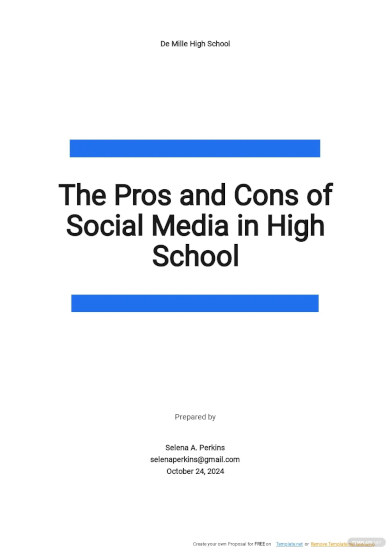
Basic Descriptive Essay Writing Example
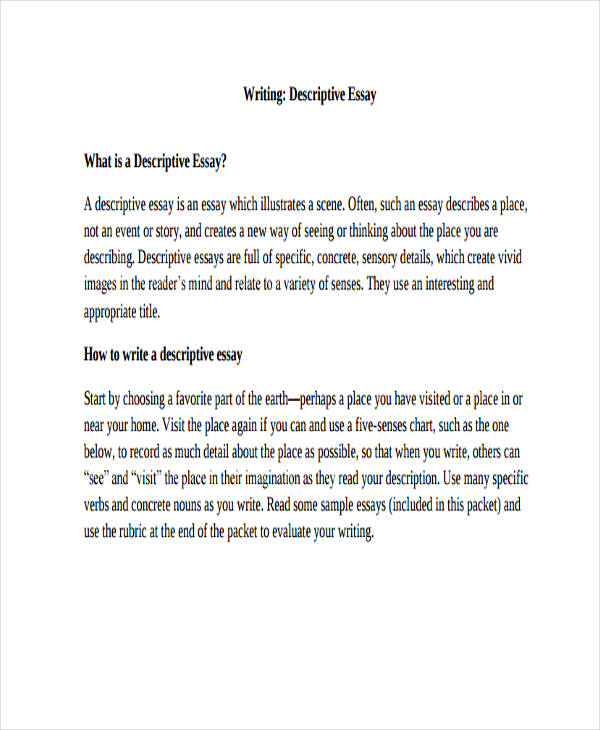
Short Descriptive Essay Example
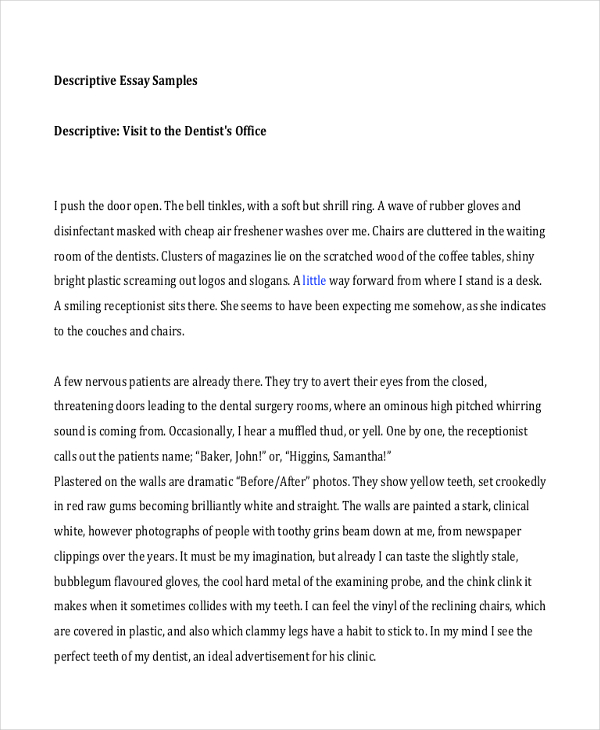
Educational Descriptive Essay Example

Basic Descriptive Essay Example
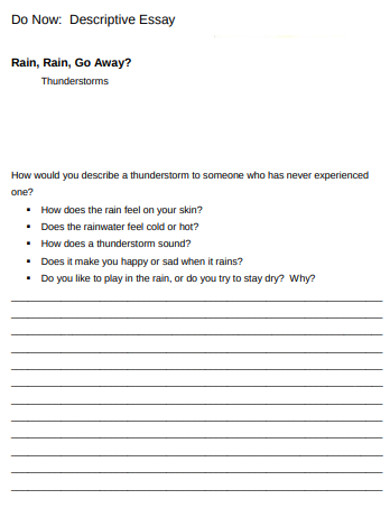
Sample Descriptive Essay Example

Professional Descriptive Essay
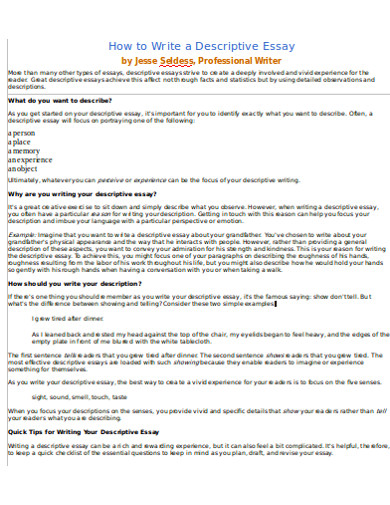
Assignment Descriptive Essay Example

How to Write Descriptive Essay?
A descriptive essay aims to provide a detailed and vivid description of a person, place, object, or event, so that the reader can visualize and experience it as if they were present. To craft an effective descriptive essay, follow these steps:
Choose a Topic
Pick something specific to describe, such as:
A memorable place (like a beach, park, or school)
A person who made an impact on you
An object that holds special meaning
An event you remember vividly (a concert, festival, or family gathering)Create a Thesis Statement
Even in a descriptive essay, it’s important to have a thesis or a central idea that guides your description. The thesis should express the importance or significance of what you’re describing.
Example:
Thesis for a Place: “The beach has always been my escape, a place where I find peace and solitude.”
Thesis for a Person: “My grandmother’s kindness and strength have made her the cornerstone of our family.”Use Sensory Details
Engage the reader’s senses by describing how the subject looks, sounds, smells, tastes, and feels. Sensory details help paint a vivid picture.
Sight: “The trees stood tall, their branches swaying in the soft breeze.”
Sound: “The distant sound of waves crashing was a constant, calming background noise.”
Smell: “The sweet smell of freshly baked bread filled the air.”
Touch: “The sand felt warm and grainy beneath my feet.”Organize Your Essay
A descriptive essay typically follows a structure of introduction, body, and conclusion:
Introduction: Introduce your subject and provide your thesis statement.
Body Paragraphs: Each paragraph should focus on a different aspect of your subject, such as its appearance, behavior, or the emotions it evokes.
Conclusion: Wrap up by reflecting on the importance of what you’ve described and how it affects you or others.Use Figurative Language
Incorporate metaphors, similes, and personification to make your description more vivid and interesting.
Simile: “The lake was as still as a mirror, reflecting the trees perfectly.”
Metaphor: “The sun was a golden orb sinking into the horizon.”
Personification: “The wind whispered softly through the trees.”Show, Don’t Tell
Instead of telling the reader what something is like, show them by providing specific details that allow them to experience it. Avoid vague language like “beautiful” or “amazing” and instead describe exactly what makes it so.
Example:
Telling: “The beach was beautiful.”
Showing: “The golden sand stretched out for miles, glistening under the warm afternoon sun, while the crystal-clear water sparkled with every wave.”Use Clear and Concise Language
Make your descriptions clear and avoid unnecessary words or overly complex sentences. Be sure to stay focused on your subject without straying into unrelated details.
Revise and Edit
After writing your essay, take time to revise it. Look for:
Clear descriptions
Strong sensory details
Proper organization of ideas
Consistency in tone and style
Types of Descriptive Essay
A descriptive essay focuses on providing a detailed description of a person, place, object, or event. There are different types of descriptive essays, each focusing on a particular aspect of description:
- Personal Descriptive Essay
Describes a person, object, or event that holds personal significance, such as a family member, a memorable location, or a specific experience. - Imaginative Descriptive Essay
Describes something that doesn’t exist or is fictional, like a fantasy landscape, imaginary creature, or futuristic city. - Objective Descriptive Essay
Provides a factual and unbiased description of something, avoiding personal feelings or opinions. It focuses on the physical attributes and features, such as describing a building, machine, or process. - Subjective Descriptive Essay
Involves personal impressions, emotions, or interpretations, often describing something from the writer’s personal perspective or feelings, like a sunset or a favorite vacation spot. - Event Descriptive Essay
Focuses on describing an event in great detail, such as a wedding, festival, or important historical moment, emphasizing its atmosphere and significance.
Each type of descriptive essay requires vivid language, sensory details, and organized structure to effectively convey the description.
Tips of Descriptive Essay
Here are some useful tips for writing a descriptive essay:
- Choose a Specific Topic
Focus on a single object, event, person, or experience to avoid overwhelming details and maintain clarity. - Use Sensory Details
Engage the reader’s senses by describing how things look, sound, smell, feel, and taste to create a vivid picture. - Show, Don’t Tell
Instead of just telling the reader how something is, show them through descriptive language and concrete imagery. For example, instead of saying “The cake was delicious,” describe its flavor, texture, and smell. - Organize Your Description
Structure your essay logically. You can organize it spatially (describing from one location to another), chronologically, or from general to specific. - Use Figurative Language
Enhance your descriptions with metaphors, similes, and personification to make your writing more engaging and relatable. - Focus on a Dominant Impression
Convey a specific mood, feeling, or overall impression that you want the reader to take away from your description. - Revise for Clarity
After writing, revise your essay to ensure that your descriptions are clear, precise, and free of unnecessary details. - Use Strong Vocabulary
Choose vivid and appropriate words to paint an accurate and colorful picture. Avoid repetitive or vague language. - Stay Objective or Subjective (As Needed)
Depending on the type of descriptive essay, decide whether you’ll remain objective (factual) or subjective (personal feelings). - Edit for Grammar and Flow
Ensure the essay flows smoothly, with good transitions between descriptions. Check for grammar, punctuation, and sentence variety.
FAQs
What is the main purpose of a descriptive essay?
The main purpose is to provide the reader with a vivid and immersive experience of the subject being described. It aims to help the reader visualize, understand, and feel the essence of what is being described.
How long should a descriptive essay be?
A descriptive essay can vary in length, but it typically ranges from 500 to 1000 words, depending on the depth of description and the level of detail required by the topic.
How do I conclude a descriptive essay?
Conclude by summarizing the key points of your description and reinforcing the dominant impression you want the reader to leave with. Avoid introducing new details in the conclusion.
What are common mistakes to avoid in a descriptive essay?
Overloading the essay with unnecessary details
Using vague or repetitive language
Failing to organize the description logically
Neglecting sensory details
Focusing too much on telling instead of showing
Can I describe more than one object or person in my descriptive essay?
While it’s possible to describe multiple objects or people, it’s generally better to focus on one to avoid overwhelming the reader with too much information. If describing multiple subjects, ensure that they are closely related and contribute to a unified impression.
What kind of language should I use in a descriptive essay?
Use vivid, sensory language that appeals to the five senses (sight, sound, smell, touch, and taste). Avoid vague words and clichés, and opt for strong adjectives, verbs, and figures of speech like similes and metaphors.


